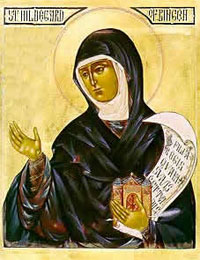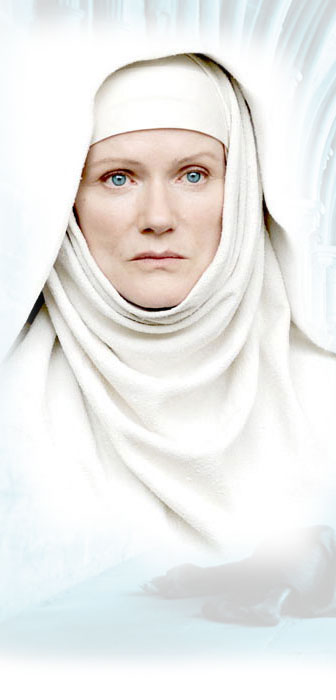 Born nearly 1000 years ago, Hildegard von Bingen (1098-1179) remains a popular figure to this day. A polymath ahead of her time who was at once spiritual and practical, von Bingen challenged Church rules and founded two convents. She was a visionary and modern theologian who, at age 60, explained the lunar eclipse not as a divine occurrence, but rather from a scientific viewpoint. With a keen mind, von Bingen was someone who believed in a positive image of humanity. A gentle revolutionary who excelled as abbess, visionary, scientist, physician, prophet, theologian and author, von Bingen was the first composer whose life we know about and was also the first woman to write about female sexuality. Centuries later, masters such as Dante and Leonardo di Vinci were inspired by her works. Hildegard von Bingen was one the most important inspirational and visionary female leaders of the Medieval age, responsible for bringing Europe out of the darkness and into the modern era of science and enlightenment. In 1233, Pope Gregor IX initiated the process of canonizing her but for formal reasons the canonization was never completed. Regardless, Hildegard von Bingen has continued to acquire an ever-expanding faction of admirers worldwide.
Born nearly 1000 years ago, Hildegard von Bingen (1098-1179) remains a popular figure to this day. A polymath ahead of her time who was at once spiritual and practical, von Bingen challenged Church rules and founded two convents. She was a visionary and modern theologian who, at age 60, explained the lunar eclipse not as a divine occurrence, but rather from a scientific viewpoint. With a keen mind, von Bingen was someone who believed in a positive image of humanity. A gentle revolutionary who excelled as abbess, visionary, scientist, physician, prophet, theologian and author, von Bingen was the first composer whose life we know about and was also the first woman to write about female sexuality. Centuries later, masters such as Dante and Leonardo di Vinci were inspired by her works. Hildegard von Bingen was one the most important inspirational and visionary female leaders of the Medieval age, responsible for bringing Europe out of the darkness and into the modern era of science and enlightenment. In 1233, Pope Gregor IX initiated the process of canonizing her but for formal reasons the canonization was never completed. Regardless, Hildegard von Bingen has continued to acquire an ever-expanding faction of admirers worldwide.
A TIMELINE OF THE LIFE OF HILDEGARD VON BINGEN
1098: Hildegard von Bingen was born in Bermershein (in what is now Germany) to Hildebert and Mechthild Burggraf von Bermersheim. She was their tenth and last child, and sickly from the time of her birth.
1106: At the age of eight, Hildegard is sent to live in a retreat adjacent to a friary in Disibodenberg. It is here that sister Jutta von Sponheim prepares her for convent life.
1113: Hildegard takes monastic vows and becomes a Benedictine nun.
1136: Von Sponheim dies and Hildegard is elected Head of her sister community by her fellow nuns.
1141: Hildegard, who claimed to have visions from a very young age, receives a prophetic call from God demanding her to record her visions. She starts writing them down with the help of Brother Volmar and Sister Richardis von Stade.
1148: Pope Eugene III hears of Hildegard von Bingen and creates a commission to determine whether her visions were divinely inspired. The commission visits her and reports the visions to be true. The Pope
recognizes Hildegard as a seer and visionary.
1150: Hildegard founds the all-female Convent Rupertsberg, near Bingen.
1151-58: Hildegard finishes her volume “Liber scivias domini” (Know the Paths of the Lord). She also writes books on natural sciences, including “Physica” (The Healing Power of Nature) and “Causae et curae” (Holistic Healing).
1158-63: Hildegard makes several teaching and missionary tours through the Rhineland and France.
1163: Hildegard writes “Liber vitae meritorum” (Book of Life’s Merits) and begins work on “Liber divinorum operum” (Book of Divine Works), the last of her texts on her visions.
1165-1170: Hildegard founds the all-female Convent Elbingen, near Rudesheim, and embarks on additional teaching and missionary tours throughout Europe.
1178: Hildegard runs into conflicts with the Church for refusing to have the body of an excommunicated man who had been buried in consecrated ground dug up. The Church rules that she is not allowed to take the Eucharist.
1179: The Church reverses the ruling against her that spring; on September 17, Hildegard von Bingen dies at the age of 81.
For more about Hildegard von Bingen see LINKS.

